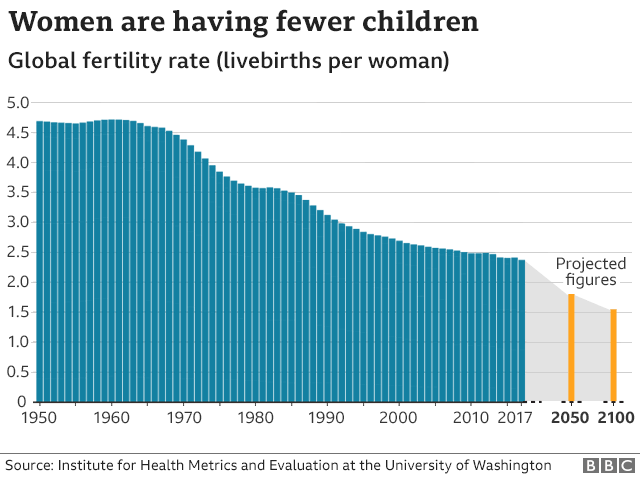Forget about “overpopulation”, dear catastrophists. Better change your tune and start preaching about “underpopulation” and “depopulation”. Demographers have known for a while that global population growth has been slowing down for decades (having peaked in 1968), but according to this amazing new study in The Lancet, global fertility is falling even faster than we think. The authors argue that global population will peak around 2064 already and then start to dwindle inexorably. Probably we will never even reach the 10 billion threshold. The title of the paper: “Fertility, mortality, migration, and population scenarios for 195 countries and territories from 2017 to 2100: a forecasting analysis for the Global Burden of Disease Study”
I just read it, and here are some highlights:
- The two major drivers of population decline are declining fertility through female education and access to contraceptives. Here’s the global fertility rate, with projections until 2100:

- In the authors’ reference scenario, world population will decline to 8.79 billion in 2100 (after peaking at around 9.73). If the UN’s Sustainable Development Goals about education are reached (but we’re not on track) world population will even decline to around 6.29 billion (!) in 2100. That’s over a billion less than today.

- In 1950, 25 babies were born for every person turning 80 years old; today that number is around seven. In 2100 the authors predict that babies and octogenarians will balance out each other: one newborn for every person turning 80. Isn’t that mind-boggling?
- All world regions will experience significant population declines during the rest of this century, with the (possible) exception of Sub-Saharan Africa. The situation looks even more dramatic if you look at the number of working-age adults in selected countries (see graph).

- Because of the huge declines in the number of working age people in China in the second half of this century, the economy of the immigration-friendly U.S. is predicted to overtake the Chinese economy again, after briefly passing the baton to China around 2050.

- These predictions of future world population are substantially lower than those of the UN population division. Why? Mostly because the models differ about what happens to countries after they fall below replacement levels (2.1 children per woman). The UN assumes that fertility levels will stabilize around 1.75. But these authors argue that the UN’s prediction is based on a biased sample of countries, and that in other countries fertility has continued to drop much further (below 1.5 children per woman). This makes a big difference in the long run.
Overall, countries can pursue four strategies to deal with these demographic shocks: (1) promote larger families with more babies (doesn’t really work); (2) restrict access to contraceptives (don’t even try); (3) increase labor force participation (works, but only as a temporary solution); (4) attract immigrants (works fairly well if you do it right). And the authors’ succinct conclusion:
“Global population is likely to peak well before the end of the century. Given that we forecasted that societies tend towards a TFR lower than 1·5, once global population decline begins, it will probably continue inexorably.”
The key word is “inexorably” here. Few social scientists make better predictions than demographers. World population will peak sooner than we think, and eventually octogenarians will rule the world! If someone starts preaching doom about “overpopulation” again, send them this paper.